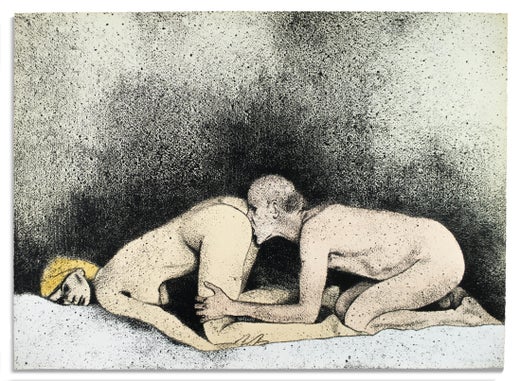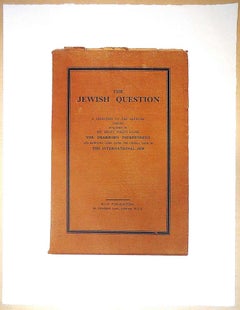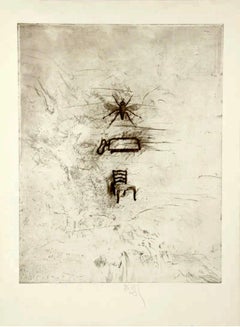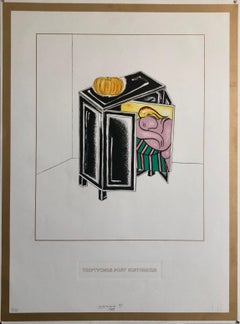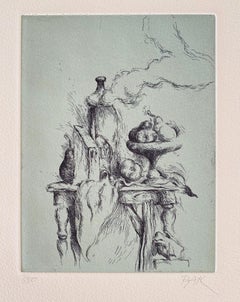Want more images or videos?
Request additional images or videos from the seller
1 of 6
Ronald Brooks KitajR.B. Kitaj "The Jerwish Question"1969
1969
$1,500List Price
About the Item
- Creator:Ronald Brooks Kitaj (1932-2007, American)
- Creation Year:1969
- Dimensions:Height: 19.97 in (50.7 cm)Width: 13.59 in (34.5 cm)
- Medium:
- Movement & Style:
- Period:
- Condition:
- Gallery Location:Surfside, FL
- Reference Number:1stDibs: LU38210505722
Ronald Brooks Kitaj
Born in Cleveland, Ohio in 1932, R.B. (Ronald Brooks) Kitaj is considered a key figure in European and American contemporary painting. While his work has been considered controversial, he is regarded as a master draftsman with a commitment to figurative art. His highly personal paintings and drawings reflect his deep interest in history; cultural, social and political ideologies; and issues of identity. Among his various honors are election to the American Academy of Arts and Letters in 1982, and election to the Royal Academy in 1985 (the first American since John Singer Sargent to receive this honor.) Numerous retrospective exhibitions of his work include shows at the Hirshhorn Museum in Washington, D.C.; The Jewish Museum, Berlin; The Jewish Museum, London; and the Hamburger Kunsthalle in Germany. Raised in Cleveland, Ohio, and Troy, New York, Kitaj joined the Merchant Marines in 1949.
In 1950, between sailings, he attended classes at the Cooper Union for the Advancement of Science and Art in New York. He went on to study drawing at the Academy of Fine Art in Vienna, Austria. Kitaj moved to Oxford, England in 1957, and enrolled at The Ruskin School of Drawing and Fine Art, University of Oxford. In 1959, Kitaj was accepted into Royal College of Art, London, where he befriended classmate David Hockney. Upon graduation from the RCA, Kitaj signed with Marlborough Fine Art, London, where he had his first solo exhibition in 1963. His art career began in earnest, and he found critical acclaim alongside commercial success. A second solo show followed at Marlborough Gallery, New York, in 1965, and he sold “The Ohio Gang” to The Museum of Modern Art. In 1969, Kitaj taught for a year at the University of California, Los Angeles. In 1976, he coined the term “School of London” in an essay he wrote as curator of the polemical exhibition, “The Human Clay,” at the Hayward Gallery, London. The term, though loose, continues to define a group of stylistically diverse artists, including Kitaj, who were working in London at that time focusing on figural representation. In 1981, he spent a year in Paris, France, where he focused on drawing and use of pastel. In 1994, the Tate Gallery, London, organized a major retrospective of Kitaj’s work. Hostile and personal attacks from some critics led to what Kitaj referred to as the “Tate War.” The exhibition subsequently traveled to the Los Angeles County Museum of Art and the Metropolitan Museum of Art, New York. Kitaj moved to Los Angeles, California, and continued to exhibit with Marlborough Fine Art and the Marlborough Gallery, New York. In 2001 the National Gallery London organized a solo exhibition of paintings: “R.B. Kitaj In the Aura of Cezanne and Other Masters.” Kitaj focused on his “late style” in his Yellow Studio in Westwood and died in 2007. His gift of his archive to the UCLA Library Special Collections was celebrated with exhibitions at the Skirball Cultural Center and UCLA’s Young Research Library.
About the Seller
4.9
Platinum Seller
Premium sellers with a 4.7+ rating and 24-hour response times
Established in 1995
1stDibs seller since 2014
1,846 sales on 1stDibs
Authenticity Guarantee
In the unlikely event there’s an issue with an item’s authenticity, contact us within 1 year for a full refund. DetailsMoney-Back Guarantee
If your item is not as described, is damaged in transit, or does not arrive, contact us within 7 days for a full refund. Details24-Hour Cancellation
You have a 24-hour grace period in which to reconsider your purchase, with no questions asked.Vetted Professional Sellers
Our world-class sellers must adhere to strict standards for service and quality, maintaining the integrity of our listings.Price-Match Guarantee
If you find that a seller listed the same item for a lower price elsewhere, we’ll match it.Trusted Global Delivery
Our best-in-class carrier network provides specialized shipping options worldwide, including custom delivery.You May Also Like
Committee 2000 (FS.II.289)
By Andy Warhol
Located in New York, NY
Screenprint in colors on Lenox Museum Board
Frame: 43.5 x 32.5 in.
Edition of 2000 (plus 200 APs)
Printed by Rupert Jasen Smith, New York
Published by Committee 2000, Munich, Germany...
Category
20th Century Pop Art Still-life Prints
Materials
Screen
Scribble Version of Still Life #58
By Tom Wesselmann
Located in New York, NY
Screenprint in 36 colours on 100% rag 4-ply Museum Board
Category
Late 20th Century Pop Art Still-life Prints
Materials
Rag Paper, Screen
Flower Garden (color trial proof) James Rosenquist Pop Art in black and white
By James Rosenquist
Located in New York, NY
Based on Rosenquist’s 1961 grisaille oil painting Flower Garden, this work arranges a still life using an advertisement for gloves with part of an athlete’s torso. A number 1 can be ...
Category
1970s Pop Art Figurative Prints
Materials
Lithograph, Screen
Iris, Lowell Nesbitt
By Lowell Nesbitt
Located in Fairfield, CT
Artist: Lowell Nesbitt (1933-1993)
Title: Iris
Year: 1981
Edition: 98/200, plus proofs.
Medium: Lithograph on Arches paper
Size: 36 x 24.75 inches
Condition: Good
Inscription: Signed...
Category
1980s Pop Art Landscape Prints
Materials
Screen
Rose, Lowell Nesbitt
By Lowell Nesbitt
Located in Fairfield, CT
Artist: Lowell Nesbitt (1933-1993)
Title: Rose
Year: 1980
Edition: 92/175, plus proofs.
Medium: Silkscreen on Arches paper
Size: 29 x 29 inches
Condition: Good
Inscription: Signed an...
Category
1980s Pop Art Landscape Prints
Materials
Screen
Lily & Rose, Lowell Nesbitt
By Lowell Nesbitt
Located in Fairfield, CT
Artist: Lowell Nesbitt (1933-1993)
Title: Lily & Rose
Year: 1974
Edition: 60/100, plus proofs.
Medium: Silkscreen on Arches paper
Size: 24 x 35.5 inches
Condition: Good
Inscription: ...
Category
1970s Pop Art Landscape Prints
Materials
Screen
Diamond Ring, Richard Bernstein
By Richard Bernstein
Located in Fairfield, CT
Artist: Richard Bernstein (1939-2002)
Title: Diamond Ring
Year: 1977
Medium: Silkscreen on Vellum paper
Edition: 177/200, plus proofs
Size: 20 x 30 inches
Condition: Good
Inscription...
Category
1970s Pop Art Still-life Prints
Materials
Screen
Ruby, Richard Bernstein
By Richard Bernstein
Located in Fairfield, CT
Artist: Richard Bernstein (1939-2002)
Title: Ruby
Year: 1978
Medium: Silkscreen on Vellum paper
Edition: 120/200, plus proofs
Size: 20 x 30.5 inches
Condition: Good
Inscription: Sign...
Category
1970s Pop Art Still-life Prints
Materials
Screen
Halston Advertising Campaign Poster - FIRST EDITION
By Andy Warhol
Located in Brooklyn, NY
This original serigraph poster was designed for an in-store advertising campaign and printed in 1982. It is part of an unnumbered edition featuring collage-style images intended for ...
Category
1980s Pop Art Still-life Prints
Materials
Screen
$1,200 Sale Price
20% Off
H 22.75 in W 29.5 in D 0.1 in
Flamingos, Lowell Nesbitt
By Lowell Nesbitt
Located in Fairfield, CT
Artist: Lowell Nesbitt (1933-1993)
Title: Flamingos
Year: 1981
Edition: 178/200, plus proofs.
Medium: Silkscreen on Arches paper
Size: 33.5 x 41 inches
Condition: Good
Inscription: S...
Category
1980s Pop Art Landscape Prints
Materials
Screen
More From This Seller
View AllR.B. Kitaj "The Jerwish Question"
By Ronald Brooks Kitaj
Located in Surfside, FL
Initialled signed in pencil From R. B. Kitaj, In Our Time: Covers for a Small Library After the Life for the Most Part, screenprint 1969 edition of 150 photo screenprint. A cover of ...
Category
1960s Pop Art Still-life Prints
Materials
Screen
Large Donald Saff Surrealist Pop Art Aquatint Etching Bee, Chair, Pot
By Donald Saff
Located in Surfside, FL
Artist: Donald Saff
Medium: Etching with Aquatint, Hand signed and numbered in pencil
Donald Jay Saff (born 12 December 1937) is an artist, art historian, educator, and lecturer, sp...
Category
1980s Pop Art Figurative Prints
Materials
Etching, Aquatint
Triptychos Post Historicus Picasso Conceptual Art Silkscreen Gold Lithograph
Located in Surfside, FL
Braco D.
Slobodan "Braco" Dimitrijević (born 18 June 1948) is a Paris-based Bosnian and Yugoslavian conceptual artist. His works deal mainly with history and the individual's place ...
Category
1980s Conceptual Still-life Prints
Materials
Lithograph, Screen
Samuel Bak Surrealist Etching Israeli Bezalel Artist "Hidden Pear", Fruit Bowl
By Samuel Bak
Located in Surfside, FL
HIDDEN PEAR, color etching, signed in pencil, numbered 7/50, Jerusalem Print workshop blind stamp, image 7 ½ x 5 ½”, sheet 15 x 10 ¼”.
Samuel Bak (born 12 August 1933) is a Polish- American painter and writer who survived the Holocaust and immigrated to Israel in 1948. Since 1993, he has lived in the United States.
Samuel Bak was born in Wilno, Poland, Bak was recognized from an early age as having an artistic talent. He describes his family as secular, but proud of their Jewish identity.
By 1939 when Bak was six years old, the war began and Wilno was transferred from Poland to Lithuania. When Wilno was occupied by the Germans on June 24, 1941, Bak and his family were forced to move into the ghetto. At the age of nine, he held his first exhibition inside the Ghetto. Bak and his mother sought refuge in a Benedictine convent where a Catholic nun named Maria Mikulska tried to help them. After returning to the ghetto, they were deported to a forced labour camp, but took shelter again in the convent where they remained in hiding until the end of the war.
By the end of the war, Samuel and his mother were the only members of his extensive family to survive. His father, Jonas, was shot by the Germans in July 1944, only a few days before Samuel's own liberation. As Bak described the situation, "when in 1944 the Soviets liberated us, we were two among two hundred of Vilna's survivors--from a community that had counted 70 or 80 thousand." Bak and his mother as pre-war Polish citizens were allowed to leave Soviet-occupied Wilno and travel to central Poland, at first settling briefly in Lodz. They soon left Poland and traveled into the American occupied zone of Germany. From 1945 to 1948, he and his mother lived in Displaced Persons camps in Germany. He spent most of this period at the Landsberg am Lech DP camp in Germany. It was there he painted a self-portrait shortly before repudiating his Bar Mitzvah ceremony. Bak also studied painting in Munich during this period, and painted "A Mother and Son", 1947, which evokes some of his dark memories of the Holocaust and escape from Soviet-occupied Poland. In 1948, Bak and his mother immigrated to Israel. In 1952, he studied art at the Bezalel Academy of Arts and Design in Jerusalem. After serving in the Israel Defense Forces, he continued his studies in Paris (from 1956 at the École nationale supérieure des Beaux-Arts) and spent various periods of time in Rome, Paris, Switzerland and Israel before settling permanently in the United States. In 2001, Bak returned to Vilnius for the first time and has since visited his hometown several times. Samuel Bak is a conceptual artist with elements of post-modernism as he employs different styles and visual vernaculars, i.e. surrealism (Salvador Dali, Rene Magritte), analytical cubism (Picasso), pop art (Andy Warhol, Roy Lichtenstein) and quotations from the old masters. The artist never paints direct scenes of mass death. Instead, he employs allegory, metaphor and certain artistic devices such as substitution: toys instead of the murdered children who played with them, books, instead of the people who read them. Further devices are quotations of iconographical prototypes, i.e. Michelangelo's "Creation of Adam" on the Sistine Ceiling or Albrecht Dürer's famous engraving entitled "Melencholia" . In the late 1980s Bak opened up about his paintings, stating they convey “a sense of a world that was shattered.” He turns these prototypes into ironical statements. Irony in the art of Samuel Bak does not mean parody or derision, but rather disenchantment, and the attempt to achieve distance from pain. Recurring symbols are: the Warsaw Ghetto Child, Crematorium Chimneys or vast backgrounds of Renaissance landscape that symbolize the indifference of the outside world. These form a disturbing contrast with the broken and damaged images in the foreground. Samuel Bak's paintings cause discomfort, they are a warning against complacency, a bulwark against collective amnesia with reference to all acts of barbarism, worldwide and throughout the ages, through his personal experience of genocide.
In Bak's piece entitled Trains Bak creates a vast grey landscape with large mounts creating the structure of a train. Massive taper candles burn in the distance further down the train tracks, surrounding an eruption. The smoke from the candles and volcano pour into a sky of dark ominous clouds that lurk over the landscape. Here Bak has created a whole new meaning for “trains.” Many of Bak’s pieces incorporate aspects of Jewish culture and the holocaust with a dark and creative twist, such as Shema Israel...
Category
20th Century Surrealist Figurative Prints
Materials
Etching
1940's Abstract Composition Jazz Lithograph Pencil Signed and Dated WPA Artist
By Konrad Cramer
Located in Surfside, FL
Konrad Cramer, 1888-1963 was a painter, photographer, printer, and illustrator.
Based in the fertile Woodstock, New York, artistic community along with Yasuo Kuniyoshi and Russell Le...
Category
1940s Abstract Abstract Prints
Materials
Lithograph
1971 Tamarind Workshop Satchel Lithograph Paul Sarkisian Photo Realist Americana
By Paul Sarkisian
Located in Surfside, FL
Paul Sarkisian (1928-)
1971 Blue Satchel or Mailbag Lithograph Silkscreen Print
on calendred BFK Rives fine art paper. small edition of 12 from Tamarind print workshop with their bli...
Category
1970s American Modern Still-life Prints
Materials
Lithograph
Still Thinking About These?
All Recently ViewedMore Ways To Browse
Jonas Wood Large Shelf Still Life
Les Diners De Gala
Salvador Dali Les Diners De Gala
Vintage Magnolia Prints
Wayne Thiebaud Etching
Yayoi Kusama Signed
Gina Lombardi
Great Exhibition 1851
Peter Max Vase Of Flowers
Vintage Cyanotypes
W Rees
Andy Warhol Flowers 1970
Antique Ballet Slippers
Connecticut Barns
David Hockney A Bigger Book
Donald Sultan Wallflowers
Karl Kasten
Litho Stone
